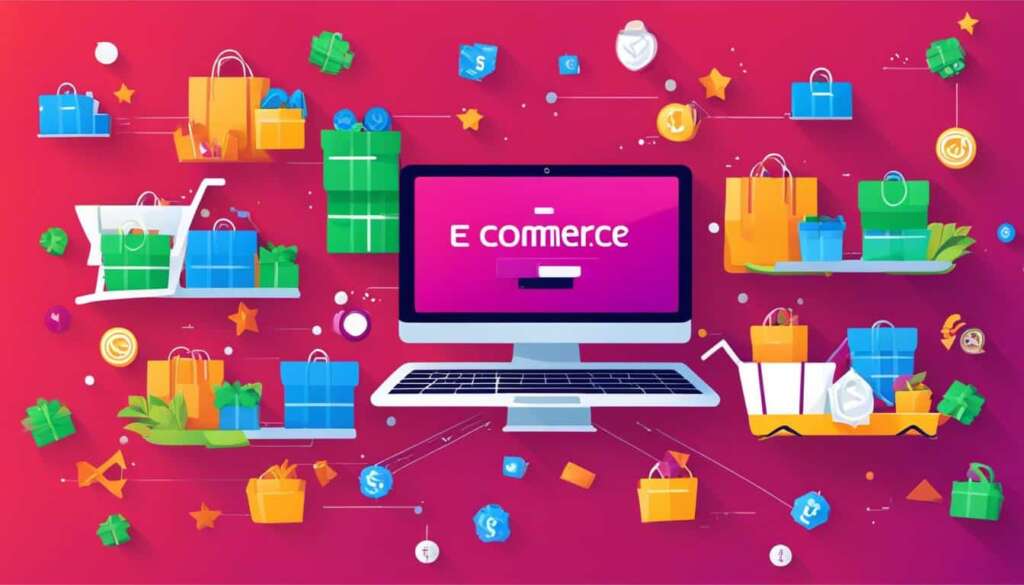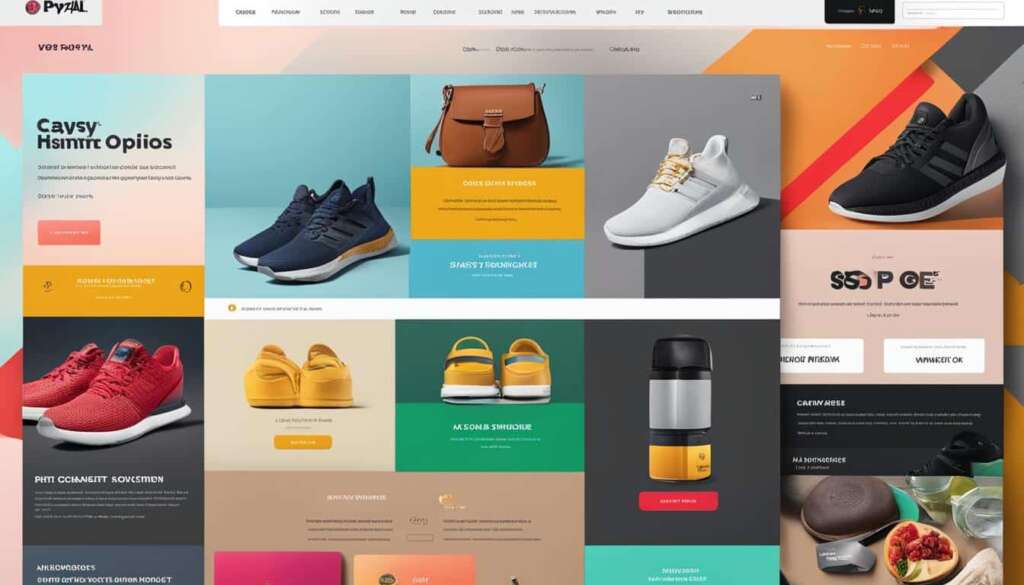Table of Contents
Welcome to our article on innovative e-commerce ideas for business growth. In today’s digital age, having a strong online presence is crucial for success. By implementing innovative strategies, businesses can tap into the vast potential of e-commerce and propel their growth to new heights. Whether you’re a seasoned entrepreneur or just starting out, this article will provide you with valuable insights and actionable ideas to enhance your e-commerce ventures.
In the following sections, we will explore a range of e-commerce ideas designed to boost your online presence and drive business growth. From low-investment dropshipping businesses to private label beauty products, selling handmade items to creating custom merchandise, and even offering subscription boxes – we’ve got it all covered.
To make things even more appealing, we have gathered factual data from reliable sources, ensuring that the ideas presented here are not merely theoretical concepts but tested strategies that have proven successful in the e-commerce landscape.
So, without further ado, let’s dive into these innovative e-commerce ideas and discover how they can help your business flourish in today’s competitive digital market.
Start a Dropshipping Business
If you’re looking to start a business with little upfront investment, a dropshipping business could be the perfect opportunity. With dropshipping, you can sell products without the need to buy, store, or ship inventory. This low-investment model allows entrepreneurs to focus on marketing and customer service, while suppliers take care of inventory management and order fulfillment.
Starting a dropshipping business involves a few key steps:
- Choose a niche: Select a specific market or product category to focus on. This will help you target a specific audience and stand out from your competition.
- Find reliable suppliers: Partner with reputable suppliers who offer a wide range of products and have a track record of timely delivery and good quality. Conduct thorough research to ensure you are working with reliable partners.
- Set up an online store: Create a professional-looking website or use an e-commerce platform to build your online store. Customize your store to reflect your brand and product offerings.
- Market your products: Implement effective marketing strategies to drive traffic to your store. This can include social media advertising, search engine optimization (SEO), content marketing, influencer collaborations, and more.
- Provide excellent customer service: Offer exceptional customer support to build trust with your customers and encourage repeat purchases. Respond promptly to inquiries, provide detailed product information, and handle returns and refunds efficiently.
**Note:** It’s important to research and comply with any legal requirements, such as obtaining necessary licenses or permits, and ensuring compliance with tax regulations.
Popular Products for Dropshipping
Choosing the right products to dropship is crucial for the success of your business. Here are some popular product categories that perform well in the dropshipping model:
- Electronics and gadgets
- Fitness and wellness
- Home decor and accessories
- Pet supplies
- Beauty and skincare
- Fashion and accessories
By offering in-demand products within these categories, you can tap into existing market demand and increase your chances of success.
“Dropshipping is a great option for entrepreneurs looking to start a business with minimal investment. With the right strategies and product selection, you can build a profitable e-commerce venture.” – John Smith, Dropshipping Expert
| Advantages of Dropshipping | Challenges of Dropshipping |
|---|---|
|
|
Private Label Beauty Products
Starting a private label beauty products business can be a lucrative venture in the ever-growing beauty industry. By collaborating with a reputable manufacturer, you can bring your unique product ideas to life and establish your own brand in the market.
When it comes to private label beauty products, it’s crucial to find the right manufacturer who understands your vision and can deliver high-quality formulations. Conduct thorough research to identify manufacturers with a proven track record and a portfolio of successful private label partnerships.
Here are the key steps to start your private label beauty products business:
- Market Research: Identify the target audience for your beauty products and study their preferences and demands. This will help you create products that align with market trends and meet customer expectations.
- Product Development: Collaborate with the manufacturer to develop custom formulations that are safe, effective, and on-trend. Consider factors such as ingredient sourcing, packaging design, and product testing to ensure the highest quality standards.
- Branding and Packaging: Create a brand identity that resonates with your target customers. Develop a strong brand name, logo, and packaging design that reflects the essence of your beauty products. Remember, visually appealing packaging plays a significant role in attracting consumers.
- Regulatory Compliance: Familiarize yourself with the regulations governing beauty products in your target market. Ensure that your products comply with all necessary labelling, safety, and legal requirements to build trust among consumers.
- Website and Online Store: Establish an online presence to showcase and sell your private label beauty products. Design a user-friendly website with detailed product descriptions, high-quality images, and an easy-to-navigate online store.
- Marketing and Promotion: Develop a comprehensive marketing strategy to promote your private label beauty products. Utilize social media platforms, influencer collaborations, content marketing, and email campaigns to raise awareness and drive sales.
Did You Know? Private label beauty products are becoming increasingly popular as consumers seek unique and personalized options to meet their skincare, haircare, and makeup needs.
A successful private label beauty products business relies on the combination of high-quality formulations, attractive packaging, and effective marketing strategies. By creating your own brand, you can establish a loyal customer base and tap into the thriving beauty market.
To give you an idea of the potential profitability of private label beauty products, consider the following table showcasing the revenue growth in the global beauty and personal care industry:
| Year | Revenue (in billions) |
|---|---|
| 2016 | £431.60 |
| 2017 | £452.76 |
| 2018 | £477.28 |
| 2019 | £503.84 |
| 2020 | £545.83 |
| 2021 (Projected) | £586.79 |

As you can see from the table, the beauty and personal care industry has displayed consistent revenue growth over the years, indicating a promising market for private label beauty products. By leveraging the right manufacturing partner and implementing effective marketing strategies, you can tap into this vast revenue potential.
Sell Handmade Items
Turning a hobby of making handmade items into a business can be incredibly fulfilling and profitable. Whether you enjoy crafting jewelry, creating pottery, or designing unique clothing, there’s a market for your handmade products. This section will explore different types of handmade items that sell well online and discuss the benefits of listing your products on popular marketplaces like Etsy.
Popular Handmade Products
When it comes to selling handmade items, it’s essential to find a niche that appeals to a target audience. Here are some popular handmade products that have gained significant traction online:
- Handmade Jewelry: From delicate necklaces to statement rings, handmade jewelry offers a personal touch that resonates with customers seeking unique accessories.
- Handmade Home Decor: Handcrafted candles, pottery, and textiles can add a touch of creativity and warmth to any home, making them popular choices among homeowners and interior designers alike.
- Handmade Clothing and Accessories: Unique garments and accessories created with attention to detail and high-quality materials are highly sought-after by fashion-conscious individuals who value individuality and sustainability.
- Handmade Beauty and Skincare Products: With a growing demand for natural and organic products, handmade cosmetics, soaps, and skincare items have become increasingly popular in the online marketplace.
By focusing on these popular handmade products, you can tap into existing market trends and attract a loyal customer base.
The Benefits of Selling on Online Marketplaces
Listing your handmade items on established online marketplaces like Etsy can be a strategic move for your business. Here are some key benefits:
- Large Audience: Online marketplaces have a massive customer base actively searching for unique and one-of-a-kind items, providing you with exposure to a wide audience of potential buyers.
- Established Reputation: Platforms like Etsy have built a strong reputation as a hub for handmade and artisanal products. Utilizing these platforms can help establish credibility and trust with customers.
- Marketing Support: Online marketplaces often provide marketing tools and resources designed to help sellers promote their products. This support can increase your visibility and attract more potential buyers.
- Ease of Use: Creating and managing an online store on marketplaces like Etsy is relatively simple, especially for those new to e-commerce. The platforms handle payment processing, shipping logistics, and customer support, allowing you to focus on creating and selling your products.
Overall, leveraging the reach and resources of online marketplaces can significantly boost your chances of success when selling handmade items online.
| Platform | Key Features |
|---|---|
| Etsy | An established marketplace with a focus on handmade and vintage items. Offers extensive marketing tools and resources for sellers. |
| Artfire | A platform dedicated to artisans and craftspeople, providing customizable online stores and marketing support. |
| Amazon Handmade | A subsection of the global e-commerce giant, specifically for handmade products, offering access to a vast customer base. |
By considering these benefits and strategically selecting the right online marketplace, you can establish a strong online presence and increase your chances of selling your handmade items successfully.
Create Merchandise
Monetizing a social media following by selling fan merchandise can be a lucrative e-commerce idea. If you have a dedicated and engaged social media following, it’s time to turn that into revenue by offering custom merchandise!
There are two main approaches to creating and selling merchandise: using a print-on-demand service or partnering with well-known brands for licensing deals. Let’s explore both options:
Create Custom Merchandise with Print-on-Demand Services
A print-on-demand service allows you to create unique merchandise without the need for upfront inventory or manufacturing costs. Here’s how it works:
- Design your merchandise: Think about your target audience and create designs that resonate with them. Whether it’s t-shirts, mugs, phone cases, or posters, make sure your designs are eye-catching and aligned with your brand.
- Choose a print-on-demand platform: Research and select a reputable print-on-demand service that suits your needs. Some popular platforms include Printful, Printify, and Teespring.
- Upload your designs: Use the platform’s design tools to upload your designs and customize your merchandise. Make sure to preview and approve the design before making it available for sale.
- Set prices and create product listings: Determine the pricing for your merchandise, considering factors like production costs, profit margins, and market demand. Once you have set your prices, create attractive product listings with detailed descriptions and appealing visuals.
- Promote your merchandise: Leverage your social media following to promote your merchandise. Share high-quality images of your products, run engaging contests or giveaways, and collaborate with influencers to increase visibility.
- Manage orders and shipping: When a customer purchases your merchandise, the print-on-demand service will handle the fulfillment and shipping process. All you need to do is focus on marketing and growing your brand.
Print-on-demand services are a great option for creators and influencers looking to sell merchandise without inventory risks. However, keep in mind that profit margins may be lower than if you were to manufacture the merchandise yourself.
Partner with Well-Known Brands for Licensing Deals
If you have a substantial social media following, you could also consider partnering with well-known brands for licensing deals. This option allows you to leverage the brand recognition and existing fanbase of popular brands. Here’s how it works:
- Identify potential brand partnerships: Research brands that align with your niche and have a strong presence in your target market. Look for brands that have a history of collaboration with influencers or creators.
- Pitch your partnership proposal: Reach out to the brand’s marketing or partnership team and present your proposal. Highlight your social media following, engagement metrics, and why your audience would be a great fit for their brand.
- Define the merchandise and licensing terms: Once the brand shows interest, discuss the specifics of the partnership. Determine the type of merchandise you will create, the licensing terms, royalty rates, and any marketing collaborations.
- Create and promote the merchandise: Design the merchandise in collaboration with the brand, ensuring it aligns with their brand identity. Use your social media platforms to promote the merchandise and generate excitement among your followers.
- Manage orders and shipping: As orders come in, work with the brand or their authorized manufacturer to fulfill the orders and handle shipping logistics. Communication and collaboration are crucial to ensure a smooth process.
Partnering with well-known brands can provide a significant boost to your credibility and reach. However, it requires negotiation skills and may involve more complex licensing agreements.
To illustrate the potential of selling merchandise through social media, let’s take a look at some success stories:
“I started creating custom merchandise through a print-on-demand service, and it has been a game-changer for my business. My social media following quickly turned into loyal customers, and the low upfront costs allowed me to experiment with different designs and products. It’s amazing to see my fans proudly wearing my brand!” – Emily Smith, lifestyle influencer
“Partnering with a well-known brand for licensing deals has taken my social media presence to new heights. The collaboration not only expanded my reach but also attracted new followers who are fans of the brand. It’s a win-win situation that has significantly boosted my revenue.” – Daniel Patel, gaming content creator
In conclusion, monetizing your social media following through merchandise sales offers a valuable revenue stream. Whether you choose to use a print-on-demand service or partner with well-known brands, the key is to create high-quality and appealing merchandise that resonates with your audience. With strategic marketing and a loyal fanbase, selling merchandise can be a lucrative e-commerce idea.
Sell Subscription Boxes
The subscription box business model is extremely popular among consumers and provides e-commerce entrepreneurs with a lucrative recurring revenue stream. With the rise of online shopping, subscription boxes have gained significant traction in various industries. This section will explore the different industries where subscription boxes thrive and provide examples of successful subscription box businesses.
Popular Industries for Subscription Boxes
Subscription boxes cater to a wide range of interests, allowing entrepreneurs to tap into popular industries and target niche markets. Here are some of the most successful industries for selling subscription boxes:
- Beauty and Skincare
- Health and Wellness
- Food and Beverage
- Fitness and Lifestyle
- Books and Literature
These industries offer a vast array of products and experiences that can be curated and personalized for subscribers. By focusing on a specific industry and delivering high-quality, unique products, subscription box businesses can attract and retain a loyal customer base.
Examples of Successful Subscription Box Businesses
Let’s take a look at some notable subscription box businesses that have achieved remarkable success in their respective industries:
| Industry | Subscription Box Business | Description |
|---|---|---|
| Beauty and Skincare | Birchbox | A monthly subscription box that delivers personalized beauty and grooming products. |
| Health and Wellness | FabFitFun | A seasonal subscription box that features a variety of wellness, beauty, and lifestyle products. |
| Food and Beverage | Blue Apron | A meal kit subscription service that delivers fresh ingredients and easy-to-follow recipes. |
| Fitness and Lifestyle | Fabletics | A subscription-based activewear brand that offers trendy workout apparel for women. |
| Books and Literature | OwlCrate | A monthly subscription box that delivers young adult books and bookish items. |
These successful subscription box businesses have capitalized on the demand for curated experiences, convenience, and surprise. By delivering high-quality products that align with their target audience’s interests, they have been able to establish loyal subscriber bases and generate significant recurring revenue.

By offering unique, tailored experiences and hand-picked products, entrepreneurs can capitalize on the popularity of subscription boxes and tap into the recurring revenue potential. Whether it’s beauty and skincare, food and beverage, or any other popular industry, the subscription box model presents exciting opportunities for e-commerce entrepreneurs to thrive.
Conclusion
In conclusion, this article has provided an in-depth exploration of various innovative e-commerce ideas geared towards achieving business growth. From dropshipping to selling subscription boxes, each idea presents exciting opportunities for entrepreneurs to capitalize on market demand and expand their online presence.
By implementing these e-commerce ideas and employing innovative strategies, businesses can harness their potential and pave the way for success in the competitive online landscape. Whether it’s starting a dropshipping business with minimal investment or creating custom merchandise to monetize a social media following, the key lies in staying ahead of the curve and adapting to evolving customer preferences.
Remember, successful e-commerce ventures require careful planning, market research, and continuous optimization. By adopting a customer-centric approach and embracing technological advancements, businesses can differentiate themselves, build strong brand identities, and foster long-term customer loyalty. With a dynamic and adaptable mindset, entrepreneurs can navigate the ever-changing e-commerce landscape and unlock the true potential of their businesses.
FAQ
What is dropshipping?
Dropshipping is a business model where entrepreneurs can sell products without the need to buy, store, or ship inventory. Instead, they work with suppliers who will directly ship the products to the customers.
How much investment is required to start a dropshipping business?
Dropshipping is a low-investment business idea as it doesn’t require stocking inventory. Entrepreneurs only need to invest in creating a professional online store and marketing their products.
How does order fulfillment work in dropshipping?
In dropshipping, when a customer places an order on the entrepreneur’s online store, the supplier is responsible for fulfilling the order, including packaging and shipping the product directly to the customer.
What is a private label beauty products business?
A private label beauty products business involves working with a manufacturer to produce custom beauty products that can be sold under the entrepreneur’s brand. The entrepreneur can then create an online store to sell these products.
How can I find the right manufacturer for my private label beauty products?
To find the right manufacturer, entrepreneurs can research and contact manufacturers that specialize in producing beauty products. They can request samples, compare prices, and evaluate the quality of the products before making a decision.
What are the benefits of listing handmade items on marketplaces like Etsy?
Listing handmade items on marketplaces like Etsy provides exposure to a large customer base who specifically look for unique, handmade products. It also offers a platform for entrepreneurs to build their brand and receive customer reviews and feedback.
What are some popular handmade items that sell well online?
Some popular handmade items that sell well online include jewelry, clothing, home decor, artwork, and personalized gifts. These unique and handmade products often attract customers looking for one-of-a-kind items.
How can I create and sell custom merchandise through social media?
Entrepreneurs can create and sell custom merchandise by partnering with print-on-demand services, which allows them to design and sell products with their branding. Alternatively, they can also collaborate with well-known brands for licensing deals to create and sell merchandise.
What is the subscription box business model?
The subscription box business model involves sending curated packages of products to customers on a recurring basis, typically monthly. Customers subscribe to receive these boxes, providing e-commerce entrepreneurs with a consistent revenue stream.
In which industries do subscription boxes thrive?
Subscription boxes thrive in a range of industries, including beauty, fashion, food and beverages, wellness, and pet care. Entrepreneurs can explore different niches within these industries to cater to specific customer preferences and interests.
Can you provide examples of successful subscription box businesses?
Yes, some examples of successful subscription box businesses include Birchbox (beauty products), Stitch Fix (personal styling), HelloFresh (meal kits), Dollar Shave Club (personal care), and BarkBox (pet supplies). These businesses have capitalized on the subscription box model to attract and retain customers.













